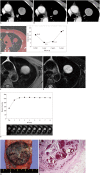Sclerosing Pneumocytoma with a Wax-and-Wane Pattern of Growth: A Case Report on Computed Tomography and Magnetic Resonance Imaging Findings and a Literature Review
- PMID: 26175598
- PMCID: PMC4499563
- DOI: 10.3348/kjr.2015.16.4.947
Sclerosing Pneumocytoma with a Wax-and-Wane Pattern of Growth: A Case Report on Computed Tomography and Magnetic Resonance Imaging Findings and a Literature Review
Abstract
Sclerosing pneumocytoma (SP) of the lung is a rare benign neoplasm. Here, we describe an unusual presentation of SP with a wax-and-wane pattern of growth in a 47-year-old woman. Tumor diameter decreased over a 3-year follow-up period and then increased on serial follow-up computed tomography scans. The mass showed high signal intensity on both T1- and T2-weighted chest magnetic resonance imaging (MRI) and early enhancement with a plateau on dynamic MRI. We speculate that intratumoral bleeding and resorption processes accounted for the changes in tumor size.
Keywords: Magnetic resonance imaging; Multidetector computed tomography; Pulmonary sclerosing hemangioma.
Figures

Similar articles
-
[Sclerosing pneumocytoma: an old disease with a rare presentation].Medicina (B Aires). 2024;84(6):1249-1251. Medicina (B Aires). 2024. PMID: 39666420 Spanish.
-
Clustered pulmonary sclerosing pneumocytoma in a young man: a case report.Clin Imaging. 2014 Jul-Aug;38(4):532-535. doi: 10.1016/j.clinimag.2014.01.016. Epub 2014 Feb 7. Clin Imaging. 2014. PMID: 24667045
-
A rare tumor of the lung: pulmonary sclerosing hemangioma (pneumocytoma).Respir Med. 2013 Mar;107(3):448-50. doi: 10.1016/j.rmed.2012.12.005. Epub 2013 Jan 2. Respir Med. 2013. PMID: 23290153
-
Radiology-pathology conference: sclerosing hemangioma of the lung.Clin Imaging. 2006 Nov-Dec;30(6):409-12. doi: 10.1016/j.clinimag.2006.05.030. Clin Imaging. 2006. PMID: 17101410 Review.
-
Sclerosing pneumocytoma mixed with a typical carcinoid tumor: A case report and review of literature.Medicine (Baltimore). 2019 Feb;98(5):e14315. doi: 10.1097/MD.0000000000014315. Medicine (Baltimore). 2019. PMID: 30702609 Free PMC article. Review.
Cited by
-
A case of pulmonary sclerosing pneumocytoma in the hilar lesion.Gen Thorac Cardiovasc Surg. 2019 Sep;67(9):818-820. doi: 10.1007/s11748-018-1043-6. Epub 2018 Nov 28. Gen Thorac Cardiovasc Surg. 2019. PMID: 30488193
-
18 F-FDG PET/CT imaging: A supplementary understanding of pulmonary sclerosing pneumocytoma.Thorac Cancer. 2019 Jul;10(7):1552-1560. doi: 10.1111/1759-7714.13100. Epub 2019 May 27. Thorac Cancer. 2019. PMID: 31131992 Free PMC article.
-
Magnetic resonance imaging findings of pulmonary sclerosing pneumocytoma: a case report and literature review.Front Oncol. 2023 Sep 1;13:1158328. doi: 10.3389/fonc.2023.1158328. eCollection 2023. Front Oncol. 2023. PMID: 37727218 Free PMC article.
References
-
- Illei PB, Rosai J, Klimstra DS. Expression of thyroid transcription factor-1 and other markers in sclerosing hemangioma of the lung. Arch Pathol Lab Med. 2001;125:1335–1339. - PubMed
-
- Devouassoux-Shisheboran M, Hayashi T, Linnoila RI, Koss MN, Travis WD. A clinicopathologic study of 100 cases of pulmonary sclerosing hemangioma with immunohistochemical studies: TTF-1 is expressed in both round and surface cells, suggesting an origin from primitive respiratory epithelium. Am J Surg Pathol. 2000;24:906–916. - PubMed
-
- Fujiyoshi F, Ichinari N, Fukukura Y, Sasaki M, Hiraki Y, Nakajo M. Sclerosing hemangioma of the lung: MR findings and correlation with pathological features. J Comput Assist Tomogr. 1998;22:1006–1008. - PubMed
-
- Liebow AA, Hubbell DS. Sclerosing hemangioma (histiocytoma, xanthoma) of the lung. Cancer. 1956;9:53–75. - PubMed
Publication types
MeSH terms
LinkOut - more resources
Full Text Sources
Other Literature Sources
Medical

